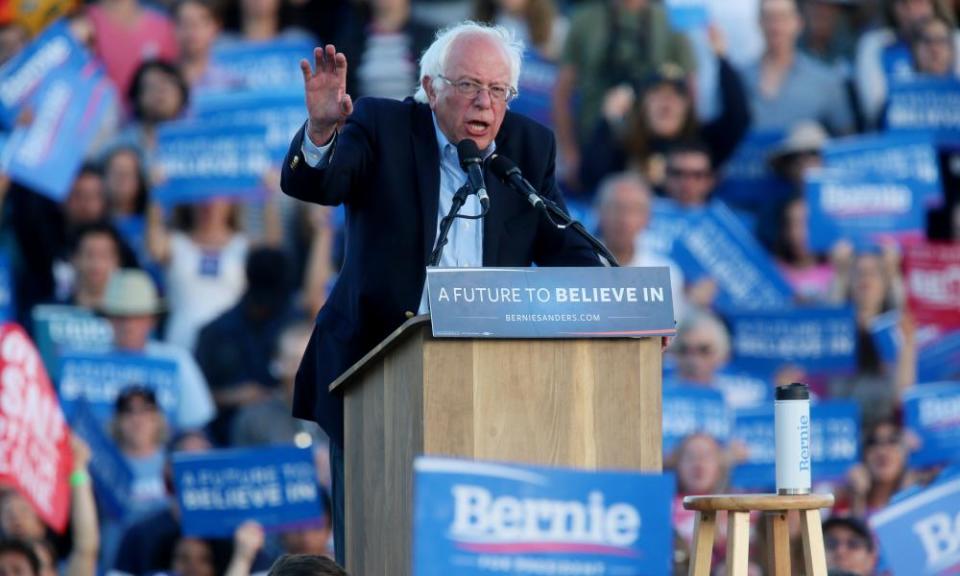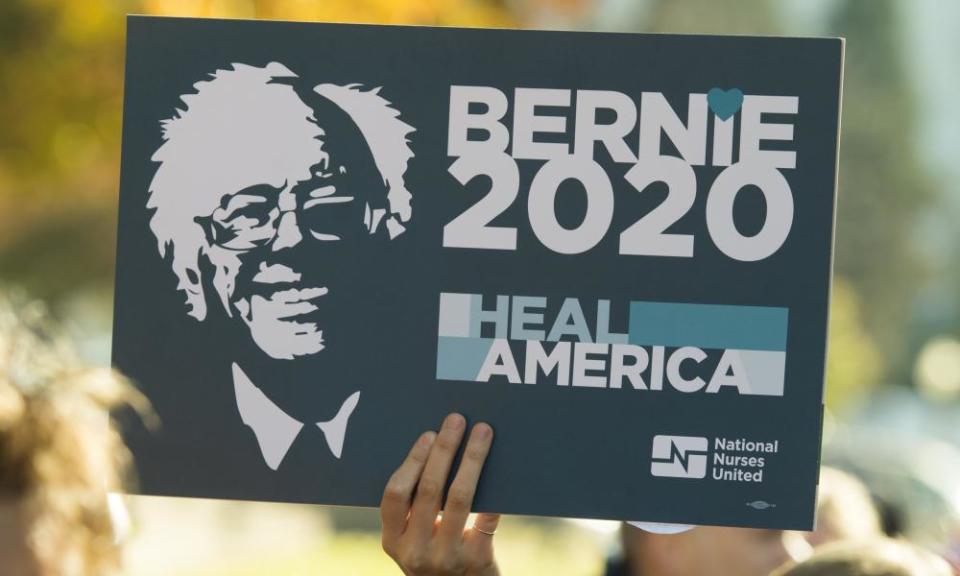Sanders started a revolution in 2016. In 2020, he can finish it

It’s official: Bernie Sanders announced today that he’s going to run for president and lay the groundwork for transforming the economic and political life of this country. His decision comes not a moment too soon.
After all, if you think things are bad now, imagine if Bernie Sanders hadn’t run for president in 2016. Imagine if Hillary Clinton had swept the primaries that year, easily parrying Martin O’Malley’s feeble blows and a few charming Lincoln Chafee debate performances.
Trump would have still beaten Clinton, but his charlatan, rightwing populism would have been the only outlet for those angry at the status quo. More than anything else, dejection would reign among voters. The Democrats would have heightened their focus on winning over “respectable” anti-Trump Republicans in the suburbs, with depoliticized calls to “fix” Obamacare, find “realistic solutions” to climate change, and make higher education “accessible”.
Forget Alexandria Ocasio-Cortez: in the early days of 2019 this would be the party of Michael Bloomberg. No surprise, in this scenario, that Trump would be polling narrowly ahead of all his contenders, the billionaire Michael Bloomberg included.
But Bernie did run in 2016 – and not just for a single campaign, but something far greater. Sanders reintroduced working-class politics in the US. It was a style based on a simple message: you work hard, we’re going to get you the dignity and security you deserve, and we’re going to fight the millionaires and billionaires standing in the way. It was a politics, in other words, that created a common narrative of struggle in which the protagonists were those trying to get by in an unfair and unequal country.
Sanders expertly communicated this message, by being as clear, direct, and honest as possible. His stump speeches used an even more limited vocabulary than Trump’s. His lines were so predictable that crowds would finish his sentences. In May 2015, he said: “This campaign is not about Bernie Sanders ... This campaign is about the needs of the American people, and the ideas and proposals that effectively address those needs,” and what endured from his campaign were precisely those ideas and proposals.
Democrats can’t call him kooky and radical this time around
Bernie Sanders talked about the need for a Green New Deal, for Medicare-for-All (now supported by a sizable majority of Americans), for tuition-free higher education, for a jobs guarantee – all now part of the mainstream debate. Most importantly, as a democratic socialist he banded these policies together in a political framework, a way of understanding the challenges facing working people and possible solutions. Sanders also encouraged his supporters by the thousands to run for elected office. Alexandria-Ocasio Cortez and Rashida Tlaib are among those who answered the call, building off Bernie’s program and reaching new audiences.
Before 2016, who could forget that the Democratic party was dominated by charter-school supporting politicians and anti-public-sector-union types like Cory Booker and Rahm Emanuel? Now 2020 candidates who were silent during the 2012 Chicago teachers’ strike are keen to show their solidarity with Los Angeles educators. It might not yet be the political revolution Sanders was calling for, but it’s testament to his influence.
The spirit of 2016 may not last forever, and it’s vital that we use the coming presidential campaign to do battle with the country’s powerful economic and political establishment. We’ll have to wait until 2024 for AOC to be eligible – for now Bernie Sanders is the only one capable of reaching millions of working Americans with the message that politics can indeed improve their lives. And not only can he continue to lay the groundwork for a left opposition to Trumpism: Bernie can actually win this time around.
Sanders lost the 2016 primary because of early Super Tuesday setbacks, particularly among black American voters. The problem wasn’t that he talked too much about class or inequality – in fact, many African American voters had similar economic views to Sanders – but rather that he wasn’t seen as credible candidate. Not enough people knew who he was, and for those who stood to lose the most from a Trump presidency, Clinton seemed like the safer bet. That’s not to mention her deep roots in the network of civic organizations and political leaders that drive turnout in southern primaries. By the time he was more established in 2016, in states like Michigan and Illinois, Sanders fared much better among black voters.
Today, Sanders is viewed favorably among most Americans, even more so among black voters than white ones, and is among the best known political figures on Earth. The once obscure junior senator from Vermont has come a long way. If Joe Biden doesn’t run, Sanders seems to be the favorite at the start of this campaign cycle – polls even show him ahead of Elizabeth Warren in her home state of Massachusetts.

His campaign infrastructure going into the primaries is also unrivaled. Sanders received the most individual campaign contributions in history – his March 2016 FEC filing alone, in a month when he received $77m in donations from those giving less than $200, was 188,613 pages long. With far more expertise and extensive email lists, Sanders won’t be starting from scratch this time around.
The young people that gave Sanders more primary votes than Clinton and Trump combined in 2016 are also primed to come out again for him. Where’s the comparable group of dedicated canvassers and social media partisans ready to back Biden?
Democrats can’t call him kooky and radical this time around. More and more Democrats, including those who are courting Wall Street, are playing lip service to progressive demands such as a $15 minimum wage and Medicare-for-All. They can’t do that and dismiss Sanders at the same time. Nor can some of the prospective Democratic candidates grumble about his age. Sanders will be 79 on Inauguration Day, but he’s in great health and Biden himself would be 78, Warren 71.
His chances in the general election against (a 74-year-old) Trump are even greater. Sanders appealed to independent voters and upset Clinton in states, like Michigan and Wisconsin, that Trump later captured. Despite having the benefits of incumbency, Trump is a historically weak candidate heading into 2020. A Politico/Morning Consult poll has him losing to Sanders 44% to 32%. With the CBO forecasting slowing economic growth in 2019 and 2020 and the administration plagued with controversy, that number might grow.
I’ve been wrong about this once before, but I’d bet that whoever the Democratic nominee is in 2020, they’ll be able to defeat Trump. That’s all the more reason to go with the most viable progressive candidate – someone committed to change and with the knowledge and willingness to do battle with the big business interests that want to hear none of it.
Near the end of his campaign in 2016, in a speech in Burlington, Sanders looked to the future: “My hope is that when future historians look back and describe how our country moved forward into reversing the drift toward oligarchy, and created a government which represents all the people and not just the few, they will note that, to a significant degree, that effort began with the political revolution of 2016.”
With the start of his 2020 bid – and with the exciting emergence of a new generation of politicians and activists who share his vision – there are more reasons than ever to believe him.
Bhaskar Sunkara is the founding editor of Jacobin magazine and a Guardian US columnist. He is the author of The Socialist Manifesto: The Case for Radical Politics in an Era of Extreme Inequality

 Yahoo News
Yahoo News 